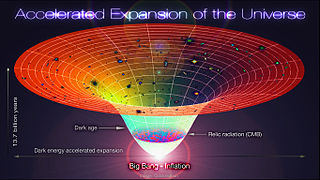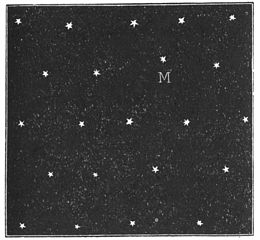
Physical cosmology is a branch of cosmology concerned with the study of cosmological models. A cosmological model, or simply cosmology, provides a description of the largest-scale structures and dynamics of the universe and allows study of fundamental questions about its origin, structure, evolution, and ultimate fate. Cosmology as a science originated with the Copernican principle, which implies that celestial bodies obey identical physical laws to those on Earth, and Newtonian mechanics, which first allowed those physical laws to be understood.
In physical cosmology, cosmic inflation, cosmological inflation, or just inflation, is a theory of exponential expansion of space in the early universe. The inflationary epoch is believed to have lasted from 10−36 seconds to between 10−33 and 10−32 seconds after the Big Bang. Following the inflationary period, the universe continued to expand, but at a slower rate. The acceleration of this expansion due to dark energy began after the universe was already over 7.7 billion years old.

Observations show that the expansion of the universe is accelerating, such that the velocity at which a distant galaxy recedes from the observer is continuously increasing with time. The accelerated expansion of the universe was discovered in 1998 by two independent projects, the Supernova Cosmology Project and the High-Z Supernova Search Team, which used distant type Ia supernovae to measure the acceleration. The idea was that as type Ia supernovae have almost the same intrinsic brightness, and since objects that are farther away appear dimmer, the observed brightness of these supernovae can be used to measure the distance to them. The distance can then be compared to the supernovae's cosmological redshift, which measures how much the universe has expanded since the supernova occurred; the Hubble law established that the farther away that an object is, the faster it is receding. The unexpected result was that objects in the universe are moving away from one another at an accelerating rate. Cosmologists at the time expected that recession velocity would always be decelerating, due to the gravitational attraction of the matter in the universe. Three members of these two groups have subsequently been awarded Nobel Prizes for their discovery. Confirmatory evidence has been found in baryon acoustic oscillations, and in analyses of the clustering of galaxies.
In modern physical cosmology, the cosmological principle is the notion that the spatial distribution of matter in the universe is equally distributed and isotropic when viewed on a large enough scale, since the forces are expected to act equally throughout the universes on a large scale, and should, therefore, produce no observable inequalities in the large-scale structuring over the course of evolution of the matter field that was initially laid down by the Big Bang.
A non-standard cosmology is any physical cosmological model of the universe that was, or still is, proposed as an alternative to the then-current standard model of cosmology. The term non-standard is applied to any theory that does not conform to the scientific consensus. Because the term depends on the prevailing consensus, the meaning of the term changes over time. For example, hot dark matter would not have been considered non-standard in 1990, but would be in 2010. Conversely, a non-zero cosmological constant resulting in an accelerating universe would have been considered non-standard in 1990, but is part of the standard cosmology in 2010.
Cosmic strings are hypothetical 1-dimensional topological defects which may have formed during a symmetry-breaking phase transition in the early universe when the topology of the vacuum manifold associated to this symmetry breaking was not simply connected. Their existence was first contemplated by the theoretical physicist Tom Kibble in the 1970s.
The Big Bounce hypothesis is a cosmological model for the origin of the known universe. It was originally suggested as a phase of the cyclic model or oscillatory universe interpretation of the Big Bang, where the first cosmological event was the result of the collapse of a previous universe. It receded from serious consideration in the early 1980s after inflation theory emerged as a solution to the horizon problem, which had arisen from advances in observations revealing the large-scale structure of the universe.
The Sachs–Wolfe effect, named after Rainer K. Sachs and Arthur M. Wolfe, is a property of the cosmic microwave background radiation (CMB), in which photons from the CMB are gravitationally redshifted, causing the CMB spectrum to appear uneven. This effect is the predominant source of fluctuations in the CMB for angular scales larger than about ten degrees.
The Lambda-CDM, Lambda cold dark matter or ΛCDM model is a mathematical model of the Big Bang theory with three major components:
- a cosmological constant denoted by lambda (Λ) associated with dark energy,
- the postulated cold dark matter, and
- ordinary matter.
The Weyl curvature hypothesis, which arises in the application of Albert Einstein's general theory of relativity to physical cosmology, was introduced by the British mathematician and theoretical physicist Roger Penrose in an article in 1979 in an attempt to provide explanations for two of the most fundamental issues in physics. On the one hand, one would like to account for a universe which on its largest observational scales appears remarkably spatially homogeneous and isotropic in its physical properties ; on the other hand, there is the deep question on the origin of the second law of thermodynamics.
An inhomogeneous cosmology is a physical cosmological theory which, unlike the currently widely accepted cosmological concordance model, assumes that inhomogeneities in the distribution of matter across the universe affect local gravitational forces enough to skew our view of the Universe. When the universe began, matter was distributed homogeneously, but over billions of years, galaxies, clusters of galaxies, and superclusters have coalesced, and must, according to Einstein's theory of general relativity, warp the space-time around them. While the concordance model acknowledges this fact, it assumes that such inhomogeneities are not sufficient to affect large-scale averages of gravity in our observations. When two separate studies claimed in 1998-1999 that high redshift supernovae were further away than our calculations showed they should be, it was suggested that the expansion of the universe is accelerating, and dark energy, a repulsive energy inherent in space, was proposed to explain the acceleration. Dark energy has since become widely accepted, but it remains unexplained. Accordingly, some scientists continue to work on models that might not require dark energy. Inhomogeneous cosmology falls into this class.

The Ehlers–Geren–Sachs theorem, published in 1968 by Jürgen Ehlers, P. Geren and Rainer K. Sachs, shows that if, in a given universe, all freely falling observers measure the cosmic background radiation to have exactly the same properties in all directions, then that universe is an isotropic and homogeneous FLRW spacetime, if the one uses a kinetic picture and the collision term vanishes, i.e. in the so-called Vlasov case or if there is a so-called detailed balance. This result was later extended to the full Boltzmann case by R. Treciokas and G.F.R. Ellis.
In physical cosmology and astronomy, dark energy is an unknown form of energy that affects the universe on the largest scales. Its primary effect is to drive the accelerating expansion of the universe. Assuming that the lambda-CDM model of cosmology is correct, dark energy is the dominant component of the universe, contributing 68% of the total energy in the present-day observable universe while dark matter and ordinary (baryonic) matter contribute 26% and 5%, respectively, and other components such as neutrinos and photons are nearly negligible. Dark energy's density is very low: 6×10−10 J/m3, much less than the density of ordinary matter or dark matter within galaxies. However, it dominates the universe's mass–energy content because it is uniform across space.

In cosmology, the steady-state model or steady state theory is an alternative to the Big Bang theory of evolution of the universe. In the steady-state model, the density of matter in the expanding universe remains unchanged due to a continuous creation of matter, thus adhering to the perfect cosmological principle, a principle that says that the observable universe is always the same at any time and any place.

In astronomy, a Hubble bubble would be "a departure of the local value of the Hubble constant from its globally averaged value," or, more technically, "a local monopole in the peculiar velocity field, perhaps caused by a local void in the mass density."

Modern searches for Lorentz violation are scientific studies that look for deviations from Lorentz invariance or symmetry, a set of fundamental frameworks that underpin modern science and fundamental physics in particular. These studies try to determine whether violations or exceptions might exist for well-known physical laws such as special relativity and CPT symmetry, as predicted by some variations of quantum gravity, string theory, and some alternatives to general relativity.

Cosmic voids are vast spaces between filaments, which contain very few or no galaxies. The cosmological evolution of the void regions differs drastically from the evolution of the Universe as a whole: there is a long stage when the curvature term dominates, which prevents the formation of galaxy clusters and massive galaxies. Hence, although even the emptiest regions of voids contain more than ~15% of the average matter density of the Universe, the voids look almost empty to an observer. Voids typically have a diameter of 10 to 100 megaparsecs ; particularly large voids, defined by the absence of rich superclusters, are sometimes called supervoids. They were first discovered in 1978 in a pioneering study by Stephen Gregory and Laird A. Thompson at the Kitt Peak National Observatory.
The "axis of evil" is a name given to the apparent correlation between the plane of the Solar System and aspects of the cosmic microwave background (CMB). It gives the plane of the Solar System and hence the location of Earth a greater significance than might be expected by chance – a result which has been claimed to be evidence of a departure from the Copernican principle as assumed in the concordance model.
Jean-Philippe Uzan is a French cosmologist and directeur de recherche employed by the Centre national de la recherche scientifique (CNRS).







